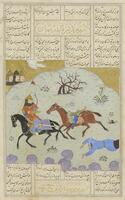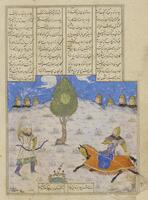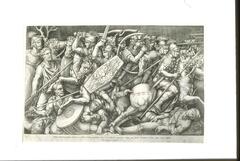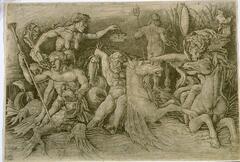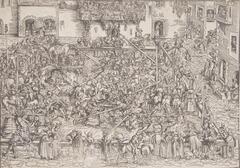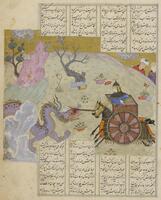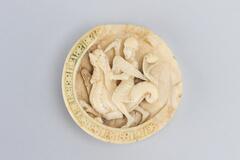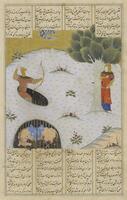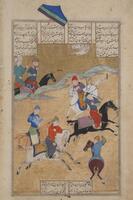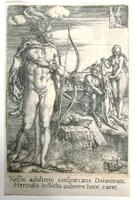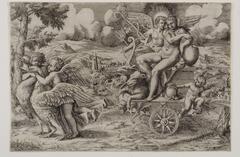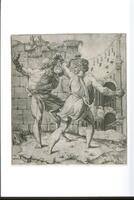14 Items in this Learning Collection
Collection Object
Collection Object
Collection Object
Collection Object
Collection Object
Collection Object
Collection Object
Collection Object
Collection Object
Collection Object
Collection Object
Collection Object
Copyright
All Rights Reserved
()
Asfandiyar Slays a Dragon, from the Shahnama of Firdausi
Accession Number
1963/1.61
Title
Asfandiyar Slays a Dragon, from the Shahnama of Firdausi
Artist(s)
Iranian
Artist Nationality
Iranian
Object Creation Date
circa 1460
Medium & Support
ink, opaque watercolor, and gold leaf on paper
Dimensions
10 1/2 in. x 7 in. ( 26.7 cm x 17.8 cm )
Credit Line
Museum purchase
Label copy
Asfandiyar, heir to the Persian throne, was released from his chains several years later, when his father Gushtasp had suffered a humiliating defeat from the Turanians. Restored to favor, Asfandiyar assumed command of the Iranian armies. During the war, he was forced to deal with seven supernatural enemies. The third of these was a fire-breathing dragon, with a body like “a mountain of flint.”
At his command some carpenters were fetched,
And therewithal some long and heavy beams.
He had a goodly wooden carriage built
All set about with swords and with a box, . . .
Wherein he sat, brought forth, attached two steeds
Of noble stock, and sped toward the dragon.
Afar it heard the rumble and beheld
The prancing of the battle steeds. It came,
Like some black mountain …
Its two eyes
Seemed fountains bright with blood, while from its gullet
Fire issued, and like some dark cavern gaped
Its jaws. It bellowed at Asfandiyar,
Who, seeing the monster, drew his breath and turned
To God for help. The horses strove to 'scape
The dragon's mischief, but it sucked them in,
Them and the break, and in his box dismayed
The warrior. In the dragon's gullet stuck
The sword-blades, and blood poured forth like a sea;
It could not free its gullet, for the swords
Were sheathed within it. Tortured by the points
And chariot the dragon by degrees
Grew weak, and then the gallant warrior,
Arising from the box, clutched his keen glaive*
With lion-grip and hacked the dragon's brains
Till fumes of venom rising from the dust
O'erpowered him; he tumbled mountain-like,
And swooned away.
Warner, V, 126–27
The wonderful purple dragon in this scene, like the fanciful clouds in the sky, derives from traditional Chinese motifs that reached Persia through the trade of textiles and ceramics.
* glaive: archaic English for sword
———
Maribeth Graybill, Senior Curator of Asian Art
Exhibited in "A Medieval Masterpiece from Baghdad: the Ann Arbor Shahnama"
August 14 through December 19, 2004
Subject matter
At his command some carpenters were fetched,
And therewithal some long and heavy beams.
He had a goodly wooden carriage built
All set about with swords and with a box, . . .
Wherein he sat, brought forth, attached two steeds
Of noble stock, and sped toward the dragon.
Afar it heard the rumble and beheld
The prancing of the battle steeds. It came,
Like some black mountain …
Its two eyes
Seemed fountains bright with blood, while from its gullet
Fire issued, and like some dark cavern gaped
Its jaws. It bellowed at Asfandiyar,
Who, seeing the monster, drew his breath and turned
To God for help. The horses strove to 'scape
The dragon's mischief, but it sucked them in,
Them and the break, and in his box dismayed
The warrior. In the dragon's gullet stuck
The sword-blades, and blood poured forth like a sea;
It could not free its gullet, for the swords
Were sheathed within it. Tortured by the points
And chariot the dragon by degrees
Grew weak, and then the gallant warrior,
Arising from the box, clutched his keen glaive*
With lion-grip and hacked the dragon's brains
Till fumes of venom rising from the dust
O'erpowered him; he tumbled mountain-like,
And swooned away.
Physical Description
This Persian miniature is attributed to the Shiraz and Timurid schools, ca. 1460. The painting is done in ink, opaque watercolor and gold leaf on paper. The scene, Asfandiyar Slays a Dragon, is part of the Shahnama of Firdausi, the Persian book of kings.
Primary Object Classification
Painting
Collection Area
Western
Rights
If you are interested in using an image for a publication, please visit http://umma.umich.edu/request-image for more information and to fill out the online Image Rights and Reproductions Request Form.
Keywords
Iranian Islamic painting styles after the Mongols
Iranian Islamic styles after the Mongols
Persian-Farsi (language)
Shahnama
Timurid
Timurid painting styles
calligraphy (visual works)
chariots
dragon
gold leaf
gouaches (paintings)
miniatures (paintings)
shahs
sword
1963/1.61
Title
Asfandiyar Slays a Dragon, from the Shahnama of Firdausi
Artist(s)
Iranian
Artist Nationality
Iranian
Object Creation Date
circa 1460
Medium & Support
ink, opaque watercolor, and gold leaf on paper
Dimensions
10 1/2 in. x 7 in. ( 26.7 cm x 17.8 cm )
Credit Line
Museum purchase
Label copy
Asfandiyar, heir to the Persian throne, was released from his chains several years later, when his father Gushtasp had suffered a humiliating defeat from the Turanians. Restored to favor, Asfandiyar assumed command of the Iranian armies. During the war, he was forced to deal with seven supernatural enemies. The third of these was a fire-breathing dragon, with a body like “a mountain of flint.”
At his command some carpenters were fetched,
And therewithal some long and heavy beams.
He had a goodly wooden carriage built
All set about with swords and with a box, . . .
Wherein he sat, brought forth, attached two steeds
Of noble stock, and sped toward the dragon.
Afar it heard the rumble and beheld
The prancing of the battle steeds. It came,
Like some black mountain …
Its two eyes
Seemed fountains bright with blood, while from its gullet
Fire issued, and like some dark cavern gaped
Its jaws. It bellowed at Asfandiyar,
Who, seeing the monster, drew his breath and turned
To God for help. The horses strove to 'scape
The dragon's mischief, but it sucked them in,
Them and the break, and in his box dismayed
The warrior. In the dragon's gullet stuck
The sword-blades, and blood poured forth like a sea;
It could not free its gullet, for the swords
Were sheathed within it. Tortured by the points
And chariot the dragon by degrees
Grew weak, and then the gallant warrior,
Arising from the box, clutched his keen glaive*
With lion-grip and hacked the dragon's brains
Till fumes of venom rising from the dust
O'erpowered him; he tumbled mountain-like,
And swooned away.
Warner, V, 126–27
The wonderful purple dragon in this scene, like the fanciful clouds in the sky, derives from traditional Chinese motifs that reached Persia through the trade of textiles and ceramics.
* glaive: archaic English for sword
———
Maribeth Graybill, Senior Curator of Asian Art
Exhibited in "A Medieval Masterpiece from Baghdad: the Ann Arbor Shahnama"
August 14 through December 19, 2004
Subject matter
At his command some carpenters were fetched,
And therewithal some long and heavy beams.
He had a goodly wooden carriage built
All set about with swords and with a box, . . .
Wherein he sat, brought forth, attached two steeds
Of noble stock, and sped toward the dragon.
Afar it heard the rumble and beheld
The prancing of the battle steeds. It came,
Like some black mountain …
Its two eyes
Seemed fountains bright with blood, while from its gullet
Fire issued, and like some dark cavern gaped
Its jaws. It bellowed at Asfandiyar,
Who, seeing the monster, drew his breath and turned
To God for help. The horses strove to 'scape
The dragon's mischief, but it sucked them in,
Them and the break, and in his box dismayed
The warrior. In the dragon's gullet stuck
The sword-blades, and blood poured forth like a sea;
It could not free its gullet, for the swords
Were sheathed within it. Tortured by the points
And chariot the dragon by degrees
Grew weak, and then the gallant warrior,
Arising from the box, clutched his keen glaive*
With lion-grip and hacked the dragon's brains
Till fumes of venom rising from the dust
O'erpowered him; he tumbled mountain-like,
And swooned away.
Physical Description
This Persian miniature is attributed to the Shiraz and Timurid schools, ca. 1460. The painting is done in ink, opaque watercolor and gold leaf on paper. The scene, Asfandiyar Slays a Dragon, is part of the Shahnama of Firdausi, the Persian book of kings.
Primary Object Classification
Painting
Collection Area
Western
Rights
If you are interested in using an image for a publication, please visit http://umma.umich.edu/request-image for more information and to fill out the online Image Rights and Reproductions Request Form.
Keywords
Iranian Islamic painting styles after the Mongols
Iranian Islamic styles after the Mongols
Persian-Farsi (language)
Shahnama
Timurid
Timurid painting styles
calligraphy (visual works)
chariots
dragon
gold leaf
gouaches (paintings)
miniatures (paintings)
shahs
sword
